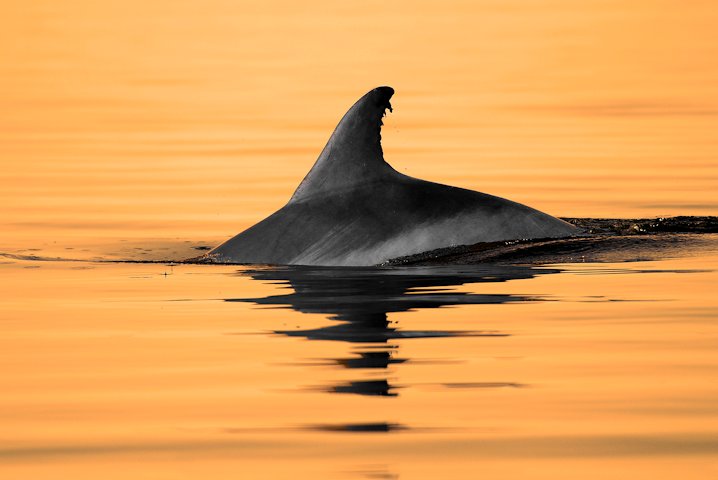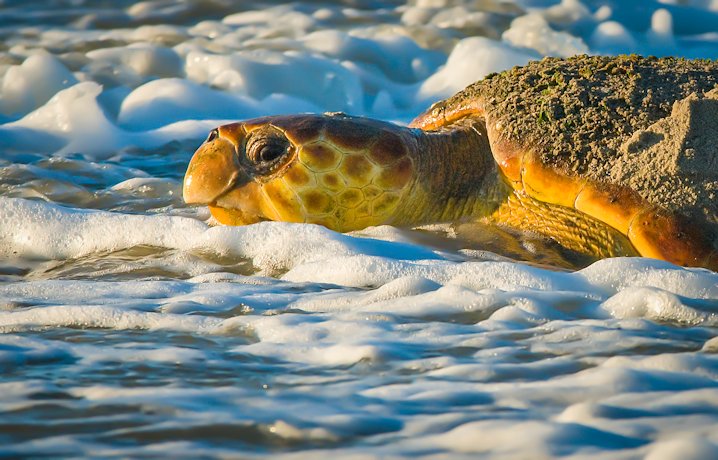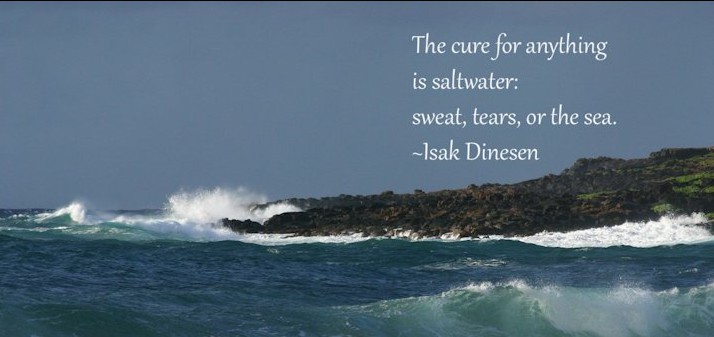BEAUFORT — The world was beginning to come alive as I pushed away from the dock. To the north of me, over Great Island, the sun was just slipping up and over the horizon as I idled out of Taylors Creek and brought my skiff onto plane. Dorsal fins of bottlenose dolphins crested the surface of the water in the orange reflection of the rising sun. Threading my way through the unmarked bars of Shark Shoal, I was heading out to check on the progress of a small egret rookery situated near the mouth of the North River. Though still early for the real excitement, birds were already beginning to show up in their full regalia of breeding plumage. A haze was rolling in off the ocean and across Back Sound, leaving a slight tang upon my lips.
This stretch of the North Carolina coast lies just below the lance shaped spit of sand known as Cape Lookout. Here, the orientation of beaches are more or less south facing. So when the southwesterly winds begin to blow, instead of pushing in that hot and oppressively humid air of the mainland such as is experienced on the Outer Banks, here beneath the cape, cool air rushes in off of the ocean. And with this pelagic air mass comes the sweet stench of salt – that intoxicating aroma of the open ocean that beckons mariners, like Homeric sirens, calling them back to the sea from which we all came.
Supporter Spotlight
I took a huge breathe, filling my lungs to full capacity with the ocean breeze. Maybe it was the extra oxygen, or maybe it was something more primal, a chemical connection to that smell of salt laden air awakening 3.4 billion years’ worth of cellular memory. But a sort of euphoria crept across my body as I exhaled my morning ration of coastal bliss.
All life came from the sea – that salty, wind tossed expanse of blue that so characterizes our planet. Our genes are linked to it. Our evolution was dictated by it. And according to Harvard biologist E.O. Wilson’s theory of Biophilia, even our psyches are inextricably connected to it. Need proof of all of this? Just take a look inside yourself.
Human blood is almost identical to seawater, 98 percent identical actually. The sodium content is the same. The mineral content is the same. Take seawater, remove one molecule of magnesium, add one molecule of iron, and you have an exact match. When life crawled itself out of the watery embrace of the oceans, it could not bring itself to fully sever its connection. Even chlorophyll, the life blood of plants if you will, shares this same 98 percent match to seawater.
I switched off the motor and trimmed the lower unit up and out of the water as my boat glided silently through the shallows, finally coming to rest on an exposed sandbar. The water was too shallow at the moment to bring my skiff into the spider web of creeks that ran through Middle Marsh. Hopping over the side of the boat, I carefully hoisted a spotting scope out of the skiff and onto the shoal for long distance viewing of the rookery, taking care that I did not get any saltwater on the optics and other parts that really mattered.
Supporter Spotlight
Salt is the great equalizer around these parts. No vehicle, outboard motor, exposed metal or electronics are completely immune to its corrosive properties. The pitting that now pock marks the stainless steel on my boats tower is a testament to this fact. As are the hints of rust forming around the edges of my old Land Cruiser.
But as corrosive as saltwater is to metals, it’s downright lethal to life on this planet. This is one of the great biological ironies I think. Despite the fact that both terrestrial plants and animals are made up of it, and need it to sustain life, a little too much salt and everything goes haywire. And when it is present in great quantities, it functions much like fire does in our longleaf forests, becoming the selective force of chaos and destruction that dictates what can and cannot survive. Adapt or die. Evolve or fade away into oblivion. Salt, along the coastline, is the grand orchestrator of life.
A few days before my morning venture out to the egret rookery, I found myself driving down N.C. 158 on the Outer Banks to hop the ferries back over to Carteret County. Instead of the verdant green of slash and loblolly pines that typifies the drive through Kitty Hawk and Nags Head, the needles of every last pine tree were brown – salt induced leaf necrosis. Only days before, a nor’easter blew up the coast. Winds barreled in off the ocean, driving massive quantities of salt spray across the islands, inundating habitats that are normally sheltered from the daily baptism in saline that characterizes life closer to the tide lines. Those species that were not adapted for handling such measures of salt, suffered as a result.

Whether it’s a matter of keeping the stuff out of your system to begin with, or adapting novels ways to expel the stuff once it begins to accumulate inside of you, survival in this kind of environment means having to evolve novel ways of protection from the destructive properties of excess salt.
Live oaks, a maritime species famously tolerant of salt spray, offers a good case in point as to how some plants manage to thrive where others burn, wither and die. The name of this tree kind of says it all. Called a “live” oak because the leaves remain green year round, this unofficial mascot of the south has adapted to salt by growing thick leathery leaves with a waxy coating over them called the cuticle. Just as you might wax your car to protect it from the elements, so too does the live oak with its leaves. Yet despite these adaptations, the seemingly indestructible live oak still must take shelter behind the dunes. And that gnarled, twisted, quintessentially wind bent look we see in the more exposed specimens, is the result of salt spray sculpting the growth of the tree always out and away from the direction of the salt.
Other species, such as the ubiquitous salt marsh cordgrass found that repelling salt in an environment regularly submerged by saltwater was futile. Instead of fortifying its exterior, this species has developed specialized glands to excrete salt from its leaves. Additionally, cordgrass, along with many other species of salt marsh plants that grow along our coast, have also developed cells with a higher concentration of amino acids to keep the fresh water that is there from leaching out through osmosis.
As I stood marooned on my shrinking sandbar watching egrets through the scope, the telltale sound of dolphins surfacing for breathes of air erupted just feet away in a channel behind me. When it comes to dealing with the problems of salt, most animals have a distinct advantage over plants in that they can simply move to higher and dryer ground when needs be. But what of marine wildlife, species such as sea turtles, pelagic birds and mammals like the coastal bottlenose dolphins hunting 25 yards away from me? What do they do? All of these creatures have returned to the ocean in order to exploit the specialized niches it provides. Like the plants that now occupy the coastal fringes of continents, these animals readapted to the salt life.
Marine wildlife all need the same things that their terrestrial cousins require for life – freshwater (amongst other things). But when at sea, there is water, water everywhere . . . but not a drop to drink. That is of course, unless you can drink saltwater.

Mammals, such as dolphins, whales, seals and sea lions have developed specialized kidneys just for solving this problem. Called a reniculate kidney, these things look more like a bag of grapes than what we typically think of as a kidney. Each one of those grapes if you will, are basically functioning like an individual kidney. And depending upon the species, there can be thousands of these that make up one reniculate kidney – all working separately yet together for the same goal. Much of the water that marine mammals ingest comes from the metabolism of their prey. But species such as dolphins still consume around six liters of saltwater a day – about 30 percent of their water intake. These reniculate kidneys work double duty to process out quantities of salt that would otherwise kill terrestrial species like you and me.
Pelagic birds on the other hand deal with salt in a very different way. Many species of birds have developed their very own desalinization plant in the form of salt glands located above their eyes. These glands are then connected to their nostrils via specialized ducts that secrete salt which runs down to the tip of the beak. Other species, known unimaginatively as tube nosed birds, collect the salt that runs from these specialized glands in a tube above their nostrils. When the salt begins to build up, every so often they will literally sneeze a briny liquid out of this tube – much to the chagrin of other seabirds nearby.
Reptiles and birds are pretty similar in how they deal with problems. This makes sense given that they are so closely related. So it should be no surprise that the great ocean going turtles of the world also developed a similar sort of desalinization plant in their heads. But Instead of salt laden aqueducts leading to nostrils, these creatures excrete the stuff from the supraorbital salt gland in the form of gelatinous saline infused tears. This unique trait has been observed by coastal peoples everywhere long before civilization. And cultures all over the world, simultaneously understood this to mean that the sea turtle was shedding tears for all of her unborn children that she would never meet after she left the beach.
As I continued my ruminations on salt and its role as a guiding hand of evolution along the coast, water began to lap at my calves. The tide was coming in and my boat was beginning to float over the sandbar I was on. Like the tide that was flooding in around me, with sea levels on the rise, one cannot help but to wonder what the effects will be on the surrounding environment. As roots become flooded out in both maritime and mainland forests, as salt water intrudes further up our river systems like we are seeing now on the Cape Fear, as we continue to lose ground to the ocean, what will the effects to our environment be? It has taken life countless millennia to readapt to a world infused with salt. Birds do not grow glands that work as desalinization plants overnight, and plants do not completely reconstruct their cellular structure in a matter of decades. Who will adapt and who will die? One thing is for certain, the little rookery on Middle Marsh now has a shelf life. And the landscape that we have taken for granted as being static and everlasting, now faces a brave new world.
But really though, this is life on a sandbar – to borrow from the philosophy of bumper stickers. Dynamic equilibrium is all that we can really hope for here. Though the hand of man is now engineering a sixth mass extinction on the planet, and swinging climate in ways that only super-volcanoes and meteorites large enough to bring the Cretaceous period to a close were capable of before, along the edge of the sea change is the only constant. And salt, that toxic yet necessary element for life, is at the forefront of driving this change.








